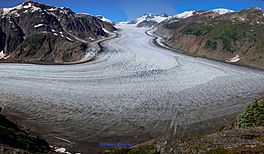Salmon Glacier facts for kids
Quick facts for kids Salmon Glacier |
|
|---|---|

View of the Salmon Glacier from the viewpoint. Mount Bayard to left, Mount White-Fraser partially visible to right.
|
|
| Type | Valley glacier |
| Location | Boundary Ranges British Columbia |
| Coordinates | 56°07′N 130°04′W / 56.117°N 130.067°W |
The Salmon Glacier is a very large glacier located in British Columbia, Canada. It is about 25 kilometers (15 miles) north of the towns of Stewart, British Columbia and Hyder, Alaska. This amazing glacier is just inside the Canadian side of the border.
The Salmon Glacier is one of many glaciers found in the Boundary Ranges mountains. It is known for something special: it can cause a natural event that might be a bit risky. Every year, around mid-July, a lake called Summit Lake is held back by a wall of ice. This ice wall breaks, and the lake's water flows under the Salmon Glacier. It then goes into the Salmon River. This causes the Salmon River to rise by about 4 to 5 feet for several days!
You can visit the Salmon Glacier by driving there from Hyder, Alaska. The road is usually open from early July to late September. The name "Salmon Glacier" was officially chosen on January 20, 1955, by the Geographical Names Board of Canada.
Climate Around the Glacier
The area where the Salmon Glacier is located has a special type of weather. It's called a marine west coast climate. This means it gets a lot of moisture from the Pacific Ocean.
How Weather Forms Here
Most of the weather systems that bring rain or snow start over the Pacific Ocean. They travel east towards the Coast Mountains. When these weather systems hit the tall mountains, they are forced to rise up. This process is called Orographic lift. As the air rises, it cools down, and the moisture in it turns into rain or snow.
Because of this, the Coast Mountains get a lot of precipitation. This is especially true during the winter months, when most of it falls as heavy snowfall. Temperatures can get very cold, dropping below -20 degrees Celsius (-4 degrees Fahrenheit). With the wind chill, it can feel even colder, sometimes below -30 degrees Celsius (-22 degrees Fahrenheit).
See also
 In Spanish: Glaciar Salmón para niños
In Spanish: Glaciar Salmón para niños

